Step off the beaten path without giving up comfort. Today’s portable homes for off-grid living make it easy to match adventurous goals with a move-in ready, efficient home that feels modern and calm.
This roundup highlights the most compelling options the market offers right now. We point out who each model serves—from minimalist solo travelers to families seeking a flexible getaway or an income property.
Expect clear, practical breaks: energy systems, water setups, safety features, interior layouts, and installation needs. Each section helps you jump straight to the details that matter.
Think season by season: plan for power, climate, and space so you can shortlist models before comparing specs and pricing. We focus on proven engineering and transparent specs to reduce surprises after delivery.
Key Takeaways
- Modern off-grid options blend autonomy with style and comfort.
- This roundup shows which buyers each model best serves.
- Sections cover energy, water, safety, interiors, and installation.
- Plan use by season to match power and space needs.
- We prioritize models with clear specs and solid engineering.
Why portable homes for off-grid living are surging right now
Many factors are reshaping where and how people choose to live. Housing scarcity, rising costs, and extreme weather push buyers toward smaller, engineered dwellings that promise lower ongoing bills and stronger resilience.
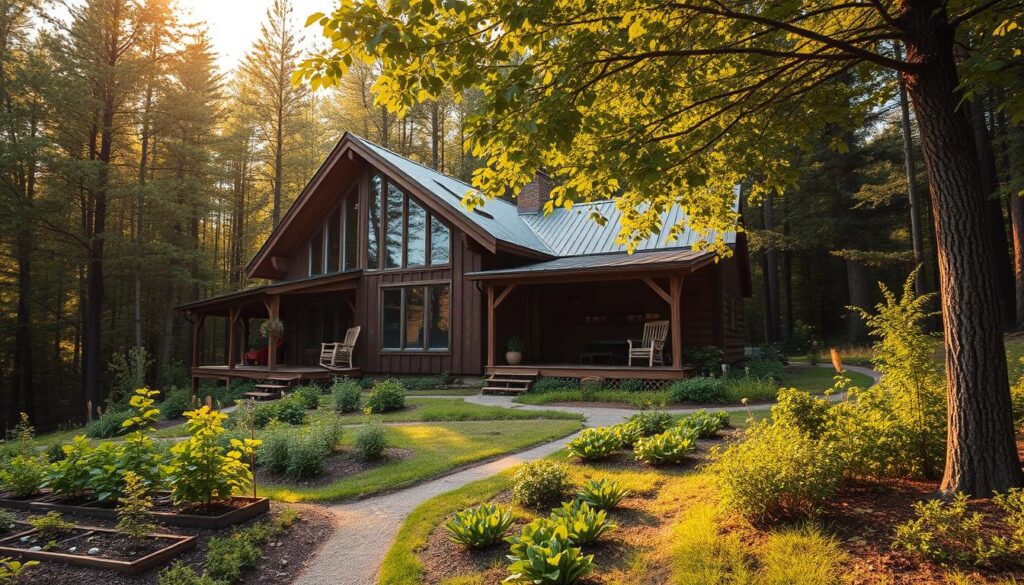
Modern engineering helps these units produce and store their own energy while improving indoor air and material health. That mix appeals to buyers who want a resilient, comfortable space that also reduces environmental impact.
- Converging trends—affordability, weather risk, and energy reliability—are driving demand.
- Factory-built processes compress build cycles, saving buyers significant time and hassle.
- Many people value the option to site a unit on land they already own, relocate seasonally, or test a property before a long-term commitment.
Policy updates and clearer code pathways in the United States are also making approvals simpler, and predictable operating costs make these units an attractive hedge against utility volatility and grid instability.
How we chose the best units for this product roundup
We tested each model against real-world autonomy goals to separate marketing claims from measurable performance. Our focus was on units that run day and night with minimal input and clear, verifiable specs.
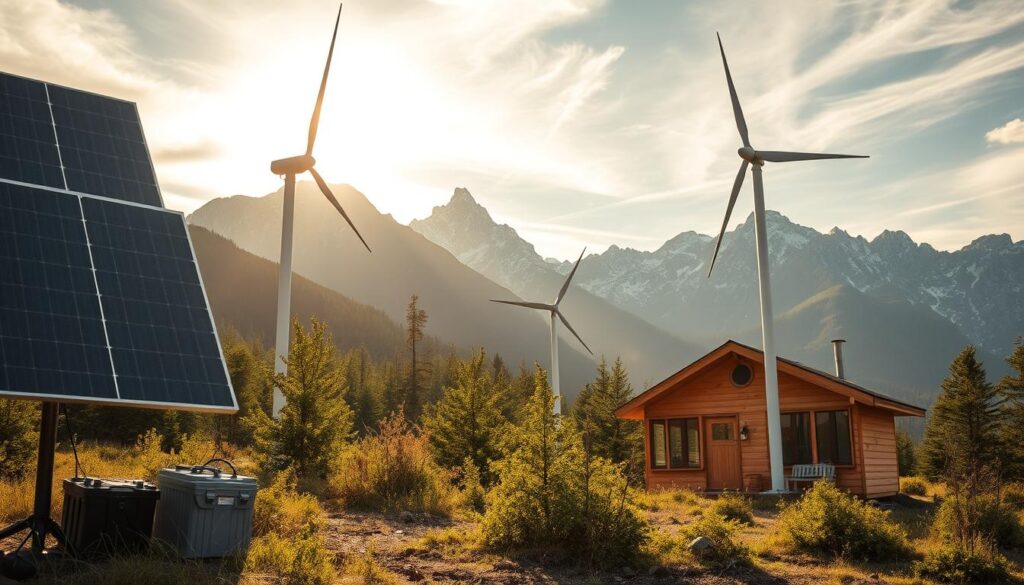
Real off-grid capability: power, water, waste that work
Real capability means a power system that supports 24/7 operation, batteries sized up to 100 kWh, autonomous waste disposal, and water-from-air or onboard tank options. We checked how those components operate together and how easy they are to maintain.
Build quality, safety, and total cost of ownership
We weighted quality heavily. That includes engineering for seismic, fire, and hurricane resistance, rust-proof composites, reinforced chassis, and tempered glass. Durable materials protect the buyer and preserve value.
Cost assessment looked beyond sticker price. We modeled energy autonomy, routine maintenance, transport, and setup efficiencies. Units with factory assembly, furnished interiors, and plug-and-play hookups scored higher because they reduce install time and surprise expenses.
Finally, we vetted compliance and support. Models with clear HUD/IRC/IBC pathways and a responsive team with transparent specs make commissioning and relocation far easier for any future owner or regulator.
Top portable homes for off-grid living on the market today
These models show how small-footprint design meets full-featured, move-in-ready systems. Each unit arrives largely finished, cutting site work and shortening the wait between delivery and occupancy.
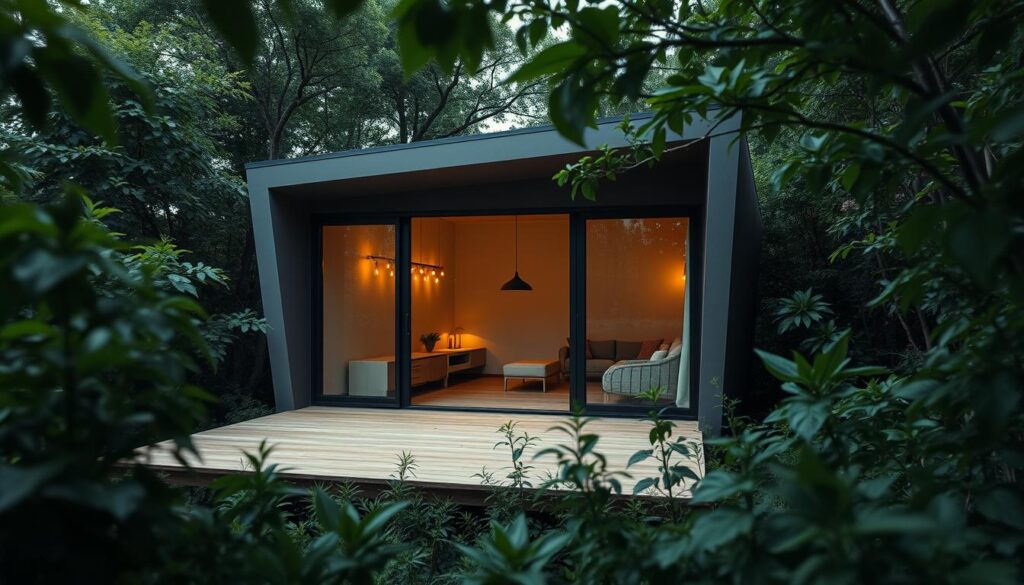
haus.me Microhaus — 120 ft², plug’n’play autonomy
Turnkey compact house: a 120 ft² manufactured unit that ships fully furnished and equipped. Plug-and-play hookups cover electricity, water, and sewage so the house is ready from day one.
Battery-packed for blackouts and featuring advanced HEPA filtration with 99.9% antibacterial/antivirus protection, the Microhaus is an entry-level offer starting near $35,000.
haus.me Off-the-Grid Studio — 400 ft², solar energy powered
At 400 ft² this option suits two to five occupants. It arrives furnished, solar energy ready, and smart-controlled for remote management.
Code compliance (HUD, IRC, IBC 2030) helps streamline approvals across many U.S. jurisdictions. Pricing starts around $160,000.
haus.me Two‑Bedroom Vacation Home — 800 ft², no foundation needed
This 800 ft² module offers family-friendly layout and refined interiors. It ships fully furnished and runs on integrated solar energy with smart controls.
No foundation requirement simplifies siting and use as a seasonal retreat or income-producing unit. Base pricing begins near $299,000.
Dvele high-performance prefab — health-centric design and energy independence
Dvele focuses on long-term performance and wellness-centered design. Their streamlined process—from floorplan to move-in—pairs energy independence with a proven delivery track record and large-scale module experience.
| Model | Footprint | Key offers | Starting price |
|---|---|---|---|
| Microhaus | 120 ft² | Plug’n’play, battery backup, HEPA | $35,000 |
| Off‑the‑Grid Studio | 400 ft² | Solar energy, HUD/IRC/IBC compliant | $160,000 |
| Two‑Bedroom Vacation | 800 ft² | No foundation, solar, furnished | $299,000 |
| Dvele | Variable | Health-centric, high-performance modules | Configured pricing |
Compare storage, footprint, and code pathways to match the right model to your budget and property limits. Each option reduces site complexity and brings autonomous energy and smart controls together for easier move-in.
Energy systems that keep you powered 24/7
A resilient power setup turns a compact house into a true 24/7 dwelling. Modern builds pair arrays, inverters, and smart controls so core living functions run automatically with minimal input.
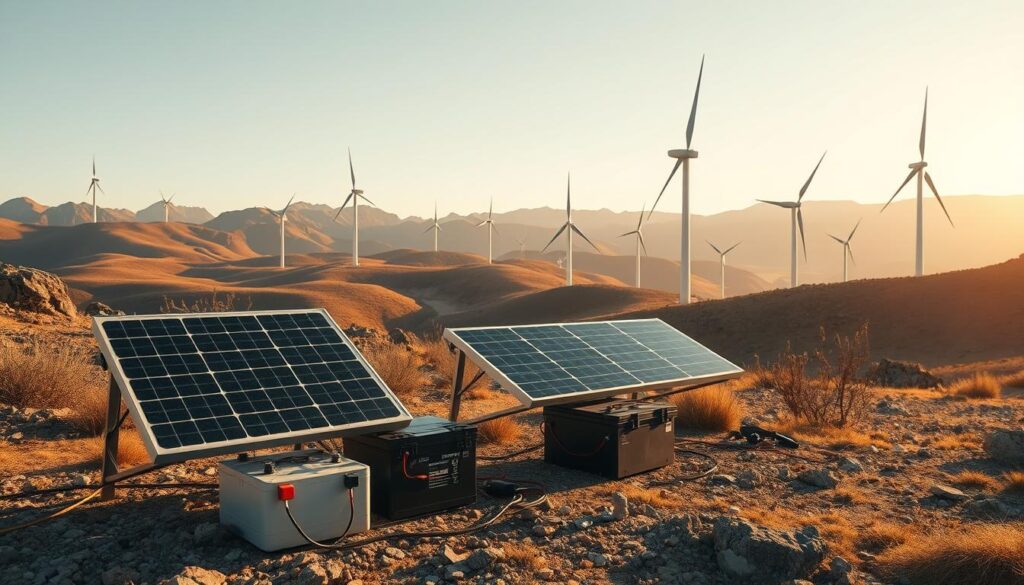
Solar energy integration and autonomous operation
Autonomous solar energy arrays feed robust inverters and smart controls. That combo lets appliances, ventilation, and lighting run during daylight and charge storage at the same time.
Battery storage up to 100 kWh and blackout resilience
Battery storage up to 100 kWh provides serious blackout resilience. It can support HVAC, refrigeration, lighting, and work equipment during extended outages without propane or firewood.
Smart electricity management across 24 intelligent subsystems
Electricity is coordinated by 24 intelligent subsystems that balance heating, cooling, ventilation, lighting, and safety. This orchestration keeps comfort high and waste low.
- Clean, quiet operation: no ongoing fuel logistics and lower routine costs.
- Power budgeting: seasonal production vs. peak loads helps you right-size arrays and storage before purchase.
- Grid optional: the house runs independently but accepts simple plug-and-play hookups where available.
- Monitoring apps: track generation, state of charge, and consumption to adjust usage over time.
Water, waste, and air: off-grid comfort without compromises
Smart water, waste, and air systems let a compact house feel like a full-featured retreat. These systems focus on redundancy and low-effort maintenance so you get consistent comfort away from municipal hookups.
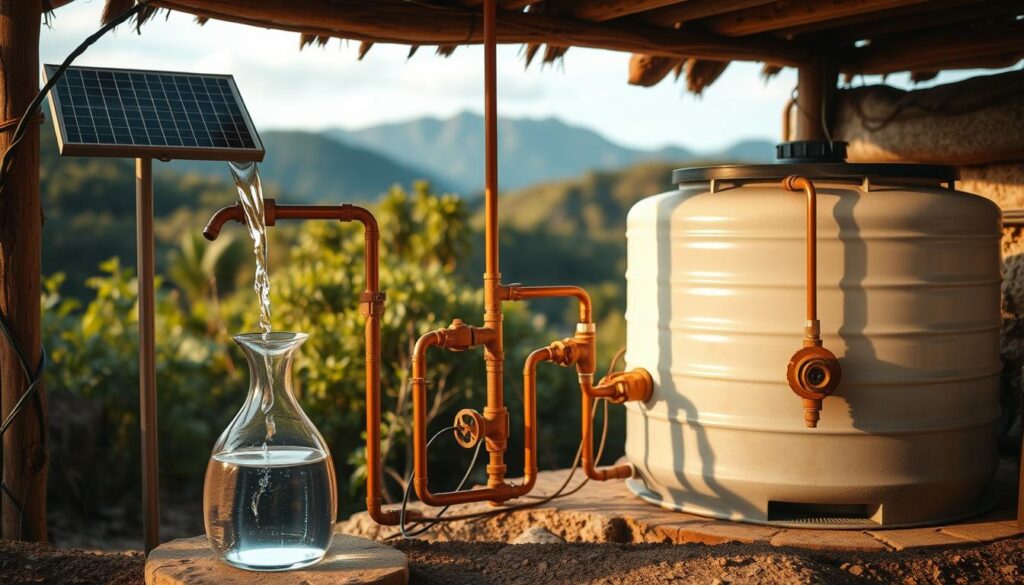
Water from air condensation and optional onboard tanks
Atmospheric water generation supplements supply by pulling moisture from air and filtering it to potable standards.
Optional tanks provide days of buffer so daily routines stay uninterrupted when weather limits production.
Autonomous waste disposal and simple hook-ups
The waste system runs autonomously with sealed composting or treatment modules that need minimal attention.
When municipal connections are available, straightforward hookups make swap-over fast and simple.
HEPA air quality control with 99.9% antibacterial/antivirus protection
Advanced HEPA filtration targets 99.9% antibacterial and antivirus particles to keep indoor air healthy.
This matters for allergy-sensitive residents and anyone who values clean, quiet ventilation.
- Routine care is simple: filter swaps, tank checks, and quick system inspections on a seasonal cycle.
- Low-flow fixtures and graywater recirculation extend supplies without cutting comfort.
Quality design ties these subsystems together so owners feel at ease. Thoughtful plumbing and intuitive controls make these homes livable, not a compromise.
Built to last: structure, safety, and climate readiness
A home’s true test is how it stands up to earthquakes, salt air, and hurricane-force winds. Design choices matter when you site in remote or exposed places.
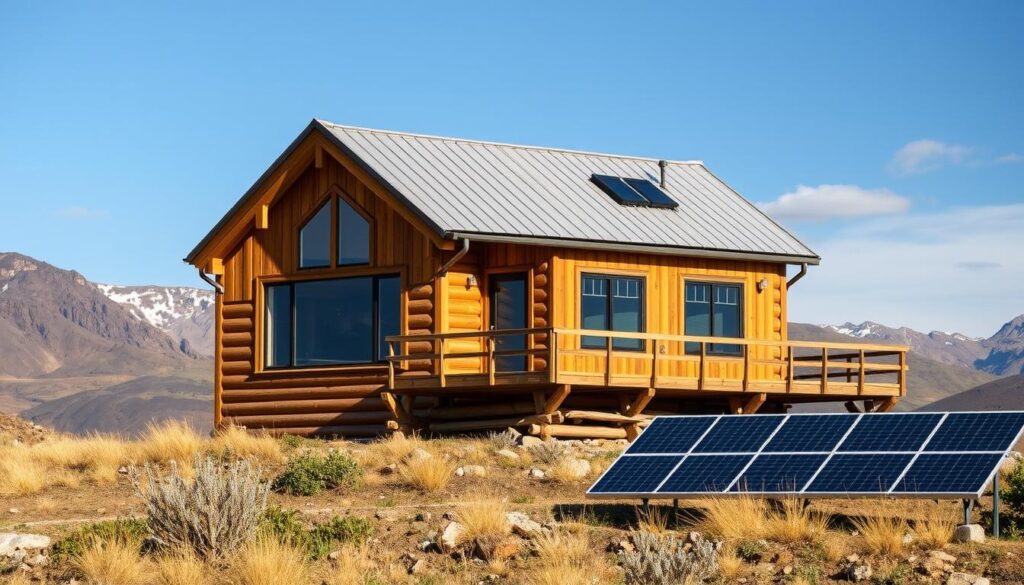
Seismic, fire, and hurricane considerations
Engineers use a reinforced chassis and tempered glass to limit movement during quakes and resist high-wind impacts.
Steel frames and shock mounts link the envelope to the chassis so the structure keeps its shape under stress.
Hot-and-cold climate packages
Rust-proof composite materials cut corrosion risk in salty coastal air and wet mountain conditions. That preserves long-term quality and lowers upkeep.
Climate packages adjust insulation, glazing, and HVAC strategies. Desert kits add thermal mass and reflective coatings.
Cold packages boost insulation, triple-glazing, and heat-recovery ventilation so the space stays efficient in alpine winters.
- Safety engineering meets strict building codes so siting on challenging terrain is simpler.
- Resilience reduces load on mechanical systems and extends battery-backed energy during outages.
- Multiple homes in this roundup are built for rugged conditions and reliable performance—connected or independent from the grid.
Design, interiors, and livability: from kitchen to smart home
Step into a finished interior where every seat, shelf, and socket is ready the moment your unit arrives. Move-in day becomes simple: furniture in place, the kitchen stocked, and the entertainment gear ready to stream. People can unpack, relax, and start their routine right away.
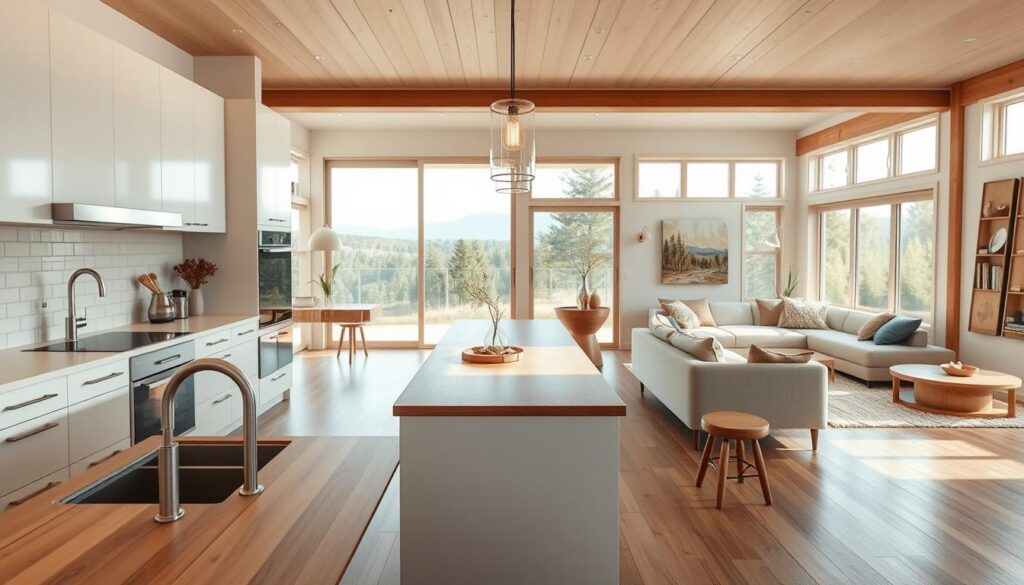
Fully furnished spaces, equipped kitchens, and multimedia
Interiors ship 100% furnished with a fully equipped kitchen that includes appliances, cookware, and smart outlets. Cabinets and convertible furnishings maximize storage without crowding the room.
Remote-controlled smart home features and satellite connectivity
Smart lighting, climate, and safety systems are coordinated across 24 subsystems to fine-tune comfort while optimizing electricity use behind the scenes.
Satellite internet keeps work and streaming reliable in remote locations. Voice and app controls let you set temperature, air filtration, security, and multimedia presets from anywhere.
| Feature | What arrives | Benefit |
|---|---|---|
| Kitchen | Appliances, utensils, stocked pantry | Ready cooking and dining from day one |
| Multimedia | High-end sound, streaming config | Entertainment without setup delays |
| Smart systems | Voice/app control, automation | Hands-free comfort and security |
| Storage & finishes | Custom cabinetry, convertible furniture | Maximizes space, keeps the house calm |
The result: a refined, welcoming home that feels larger than its footprint. Thoughtful materials and clean-lined finishes make daily life simple and enjoyable, whether you host guests or savor quiet mornings alone.
Buying in the United States: codes, permits, and installation
Understanding permitting and delivery options early saves weeks of time and avoids costly surprises. Select models list clear code pathways—HUD, IRC, and IBC 2030—which can streamline approvals and inspections across many jurisdictions.
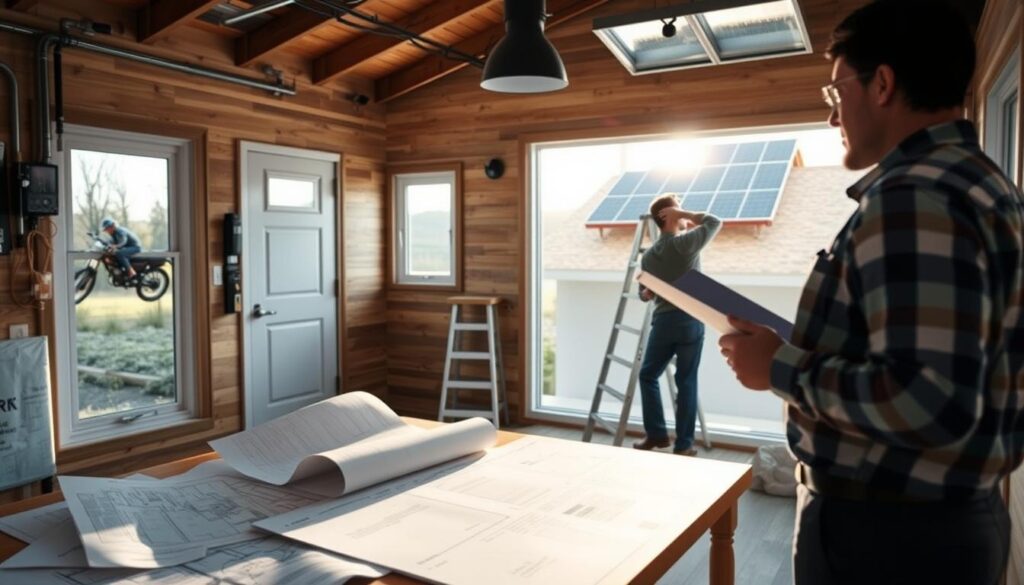
HUD, IRC, and IBC 2030 compliance for smoother approvals
Certified compliance matters. Units that meet HUD, IRC, or IBC 2030 standards often pass local review faster. Still, confirm county or city requirements early so permit timelines stay predictable.
No foundation needed and same-day installation options
Many models arrive assembled and fully furnished. They can be set on any level surface with no permanent foundation.
Same-day installation can cut project time dramatically, letting buyers occupy the home within hours of delivery when site prep is minimal.
Transport, delivery, and specialized logistics
Standard truck delivery covers most sites. For steep or remote properties, manufacturers also offer transportable options and helicopter airlift.
“Coordinate logistics and permits up front to keep delivery and commissioning aligned.”
The installation flow: delivery → leveling and anchoring → hook up electricity, water, and sewage → final inspection → commissioning. Plug-and-play offers for electricity, water, and sewage allow flexible operation: fully independent or lightly connected where services exist on site.
| Step | Typical duration | Outcome |
|---|---|---|
| Permits & reviews | 1–8 weeks | Local clearance for siting and utilities |
| Delivery & placement | Same day to 3 days | Unit on site, leveled, anchored |
| Hookups & commissioning | Hours to 2 days | Power, water, sewage online; final tests |
| Final inspection | 1–7 days | Occupancy approval |
Work closely with the provider’s team and local officials to align permits, inspections, and utility plans. That coordination keeps the project on schedule and reduces surprise costs.
Which off-grid home fits your lifestyle and budget?
Choosing the right unit starts with how you plan to use it. Match household size, seasonal needs, and expected uptime before you pick a model. That will guide bedroom count, storage, and system sizing.
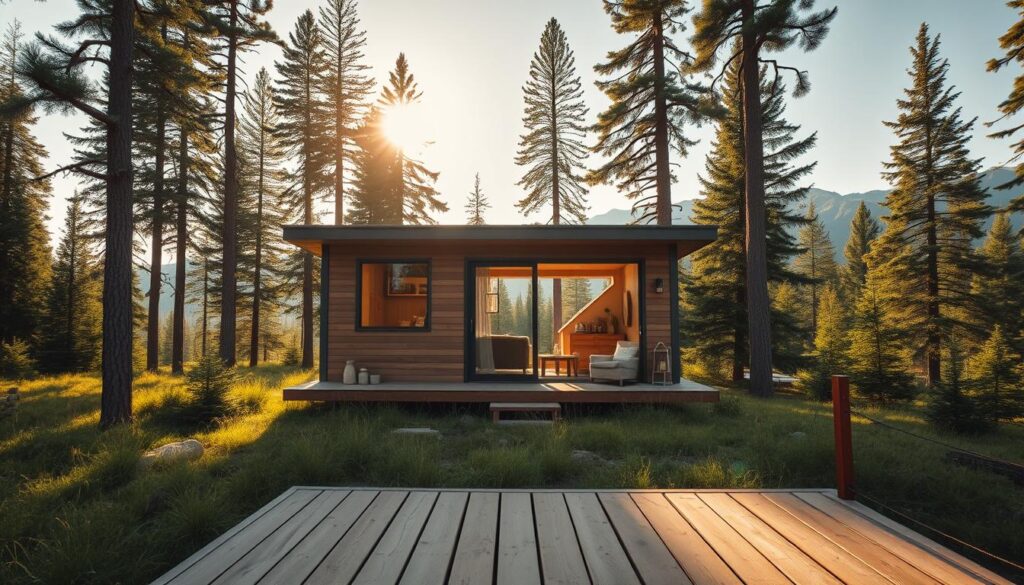
Solo, couple, or family: choosing between 1–3 bedrooms
Solo buyers benefit from compact footprints like the Microhaus. A small home is cheaper to site and simple to power and maintain.
Couples often land on mid-size units. These balance open living with private sleeping space and enough storage for work-from-home needs.
Families should consider one- to three-bedroom layouts. The 800 ft² two-bedroom house is a strong sweet spot for comfort without losing portability.
Primary residence, vacation house, or short-term rental unit
Decide the use case early. A primary home needs long-term durability and larger storage. A vacation or rental can prioritize quick turnover and low maintenance.
- Rental-ready: choose durable finishes and easy-clean surfaces to speed turnovers.
- Systems: solar with storage and optional onboard tanks cut monthly costs by boosting power and water autonomy.
- Move-in speed: furnished interiors and a full kitchen shorten setup and let income start sooner.
Tip: draft a shortlist by use case—primary, vacation, or rental—and schedule a consult. Confirm capacity, storage, and seasonal performance before you buy.
Ready to live off the grid? Compare models and connect with a team today
Make a confident choice by comparing footprint, bedroom count, storage capacity, climate packages, and delivery timelines side by side. This quick checklist helps you see which units match your site and budget.
Schedule a call with a knowledgeable team to review site conditions, code pathways, and electricity and energy needs before you finalize an order.
Most providers ship factory-assembled, fully furnished units that arrive ready-to-go. Optional battery storage and onboard tanks cut setup complexity in remote sites and speed move-in.
Next steps: request spec sheets, confirm pricing and lead times, and lock delivery windows. The same team will help commission systems, tune settings, and plan future upgrades.
Start the process now so your new unit is ready when the season and your schedule align.

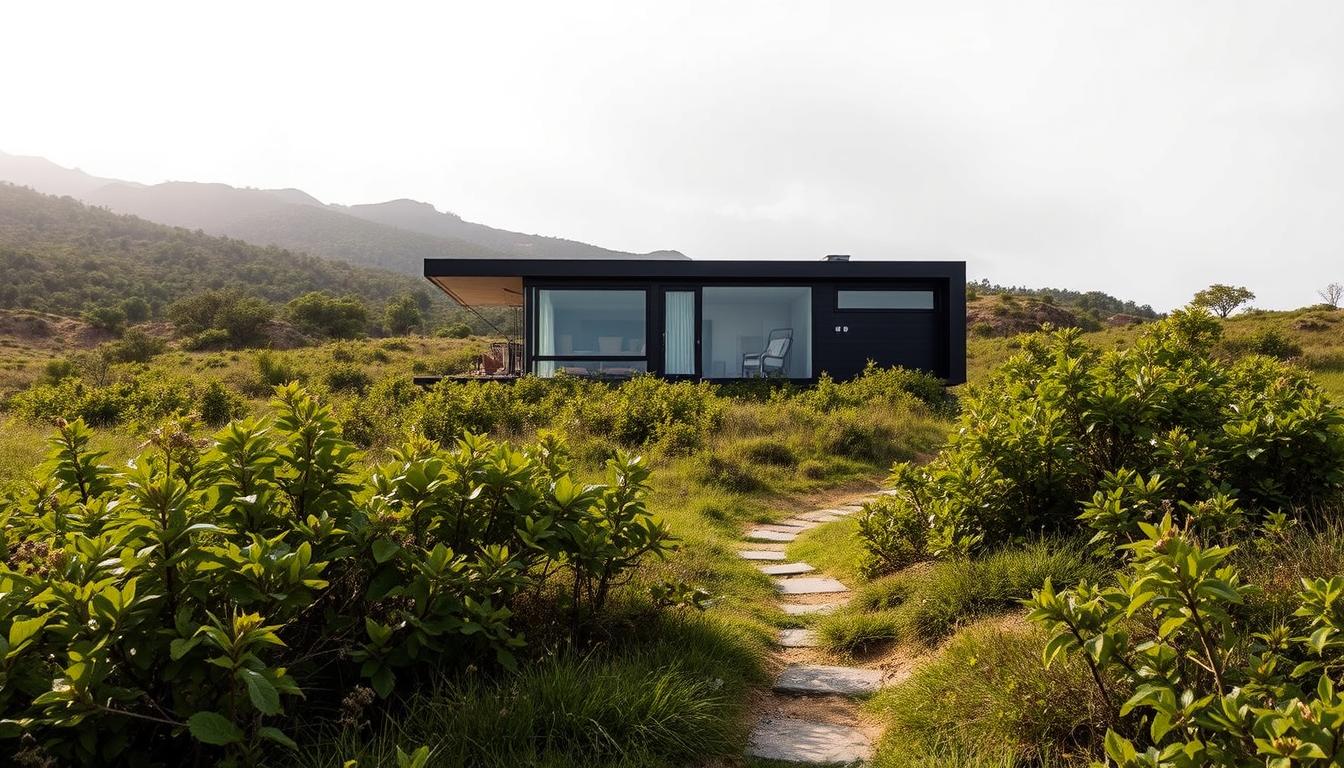
Leave a Reply